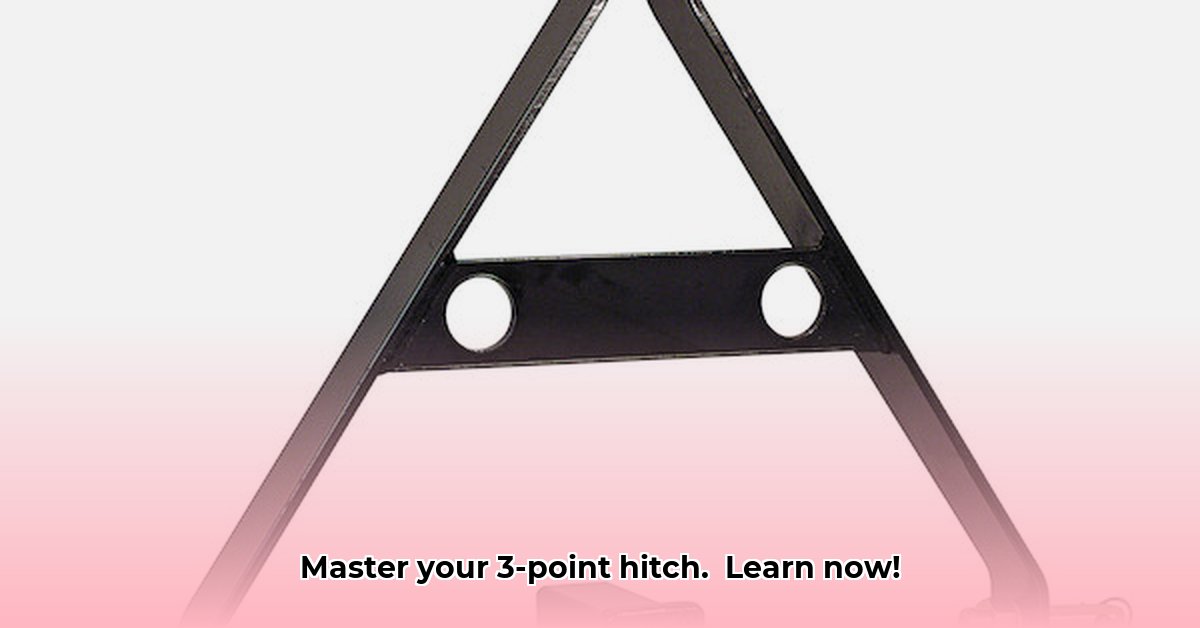
This comprehensive guide provides farmers of all skill levels with the knowledge and steps necessary to safely and efficiently utilize 3-point hitch tractor receiver hitches. Understanding your hitch system is crucial for maximizing productivity and ensuring your safety. For more information on lawn tractor hitches, see this helpful guide: Lawn Tractor Hitches.
Understanding 3-Point Hitch Categories: Finding the Right Fit
3-point hitch categories (0-4) represent weight classes, indicating your tractor's lifting capacity. Matching the correct category to your tractor and implements is paramount. Using an improperly sized hitch poses significant risks.
| Category | Lifting Capacity (lbs) | Typical Tractor Horsepower | Common Implement Examples |
|---|---|---|---|
| 0 | Up to 1,000 | Under 20 | Small cultivators, seed drills |
| 1 | 1,000 - 3,000 | 20 - 40 | Mowers, small balers |
| 2 | 3,000 - 6,000 | 40 - 75 | Larger mowers, medium-sized implements |
| 3 | 6,000 - 10,000 | 75 - 125 | Larger implements, heavier-duty work |
| 4 | 10,000+ | 125+ | Large implements, specialized equipment |
Always consult your tractor's owner's manual for precise weight limits. Overloading can irreparably damage your tractor and jeopardize your safety. Isn't it better to be safe than sorry?
Anatomy of a 3-Point Hitch System: The Key Components
The 3-point hitch is composed of several interconnected parts working in harmony. Understanding their functions is essential for proper operation.
Top Link: The vertical connection between the implement and the tractor, controlling the implement's angle.
Lower Links: The two lower arms connecting the implement to the tractor, providing lift and stability. Adjustable lengths allow fine-tuning implement placement.
Draft Arms (Optional): Assist in controlling draft force when pulling implements like plows. Not all implementations will have these.
Hydraulic Control System: The system that raises and lowers the implements. This system is crucial for safe and productive work.
A diagram would be helpful here to visually represent these components and their interactions.
Connecting Implements with a Receiver Hitch: A Step-by-Step Guide
Attaching implements safely and correctly is paramount. Follow these steps:
Compatibility Check (Critical): Verify that your implement's category matches your tractor's hitch category.
Precise Positioning: Carefully back your tractor up to the implement, aligning the hitch pins. Take your time—precision is key.
Lower Links First: Connect the lower links securely, ensuring the pins are firmly locked.
Top Link Attachment: Securely attach the top link, verifying a firm connection at both ends.
Gently Raise: Use the hydraulics to slowly raise the implement. Observe the movement carefully.
Final Inspection (Safety First): Double-check all connections before operation.
Detaching is the reverse process. Lower the implement completely before disconnecting.
Routine Maintenance and Troubleshooting: Keeping Your Hitch Running Smoothly
Regular maintenance prevents costly repairs and extends the life of your hitch.
Lubrication: Regularly lubricate all moving parts (pins, bushings, hydraulic cylinders).
Inspection: Regularly inspect for bent or broken parts, particularly pins and bushings. Replace any damaged components.
Cleaning: Remove mud and debris to prevent interference with the hitch's operation.
Common Problems:
Hydraulic Leaks: Address immediately to prevent costly damage.
Pin Wear: Replace worn pins to maintain secure connections.
Proactive maintenance saves time and money in the long run. You will find this preventative maintenance checklist helpful:
Prioritizing Safety: Essential Precautions
Safety should always be your top priority.
Avoid Overloading: Never exceed the hitch's weight capacity.
Secure Connections: Ensure all connections are secure before starting.
Controlled Lifting: Avoid sudden or jerky movements during operation.
Situational Awareness: Be aware of your surroundings at all times.
Remember, following these precautions reduces risks and promotes long-term safety.
Additional Resources: Expanding Your Knowledge
Your tractor's owner's manual is an indispensable resource specific to your model and hitch. Regularly consult it for complete and precise information. Your local agricultural equipment dealership can also offer assistance and expert advice when required.
How to Choose the Right 3-Point Hitch Category for Your Tractor
Choosing the correct 3-point hitch category is critical for safe and efficient operation. Improper matching risks equipment damage and compromises safety.
Matching Your Tractor and Implements: A Step-by-Step Process
Consult your Tractor Manual: Determine your tractor's hitch category from the owner's manual or a decal on the tractor.
Check the Implement's Category: Confirm the category rating on the implement's label or documentation.
Ensure Compatibility: The implement's category must match or be lower than your tractor's category (using adaptors if necessary).
Pin Diameter Verification: Verify the pin diameter for correct fitment. This is a critical safety check.
Lower Link Alignment is Crucial: Ensure accurate alignment of the implement’s and tractor’s lower links before operation.
Test Lift Functionality: After connection, check the lift system's smooth operation.
Remember, choosing the correct category ensures longevity and safety for you and your equipment.